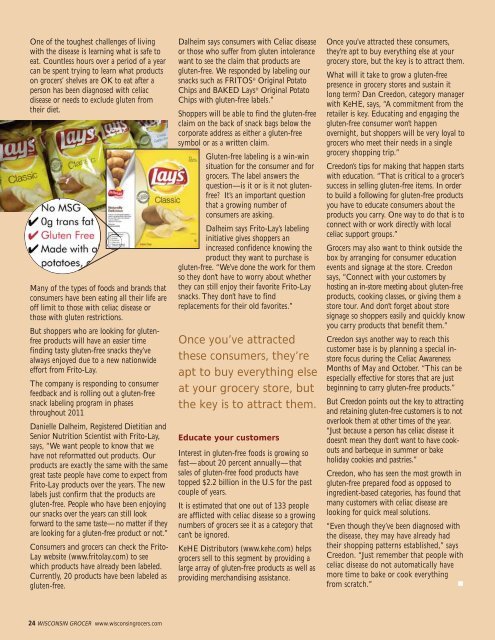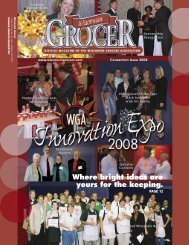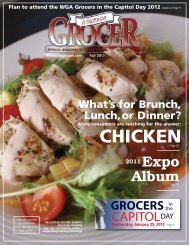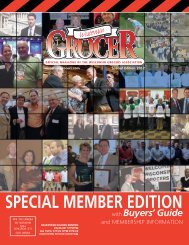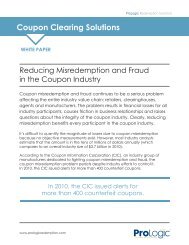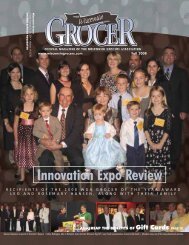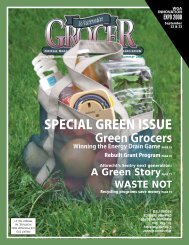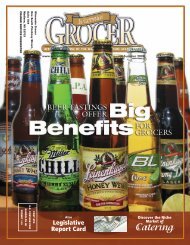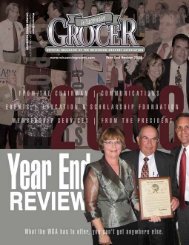Gluten-Free Stores - Wisconsin Grocers Association
Gluten-Free Stores - Wisconsin Grocers Association
Gluten-Free Stores - Wisconsin Grocers Association
Create successful ePaper yourself
Turn your PDF publications into a flip-book with our unique Google optimized e-Paper software.
One of the toughest challenges of living<br />
with the disease is learning what is safe to<br />
eat. Countless hours over a period of a year<br />
can be spent trying to learn what products<br />
on grocers’ shelves are OK to eat after a<br />
person has been diagnosed with celiac<br />
disease or needs to exclude gluten from<br />
their diet.<br />
Many of the types of foods and brands that<br />
consumers have been eating all their life are<br />
off limit to those with celiac disease or<br />
those with gluten restrictions.<br />
But shoppers who are looking for glutenfree<br />
products will have an easier time<br />
finding tasty gluten-free snacks they’ve<br />
always enjoyed due to a new nationwide<br />
effort from Frito-Lay.<br />
The company is responding to consumer<br />
feedback and is rolling out a gluten-free<br />
snack labeling program in phases<br />
throughout 2011<br />
Danielle Dalheim, Registered Dietitian and<br />
Senior Nutrition Scientist with Frito-Lay,<br />
says, “We want people to know that we<br />
have not reformatted out products. Our<br />
products are exactly the same with the same<br />
great taste people have come to expect from<br />
Frito-Lay products over the years. The new<br />
labels just confirm that the products are<br />
gluten-free. People who have been enjoying<br />
our snacks over the years can still look<br />
forward to the same taste—no matter if they<br />
are looking for a gluten-free product or not.”<br />
Consumers and grocers can check the Frito-<br />
Lay website (www.fritolay.com) to see<br />
which products have already been labeled.<br />
Currently, 20 products have been labeled as<br />
gluten-free.<br />
Dalheim says consumers with Celiac disease<br />
or those who suffer from gluten intolerance<br />
want to see the claim that products are<br />
gluten-free. We responded by labeling our<br />
snacks such as FRITOS ® Original Potato<br />
Chips and BAKED Lays ® Original Potato<br />
Chips with gluten-free labels.”<br />
Shoppers will be able to find the gluten-free<br />
claim on the back of snack bags below the<br />
corporate address as either a gluten-free<br />
symbol or as a written claim.<br />
<strong>Gluten</strong>-free labeling is a win-win<br />
situation for the consumer and for<br />
grocers. The label answers the<br />
question—is it or is it not glutenfree?<br />
It’s an important question<br />
that a growing number of<br />
consumers are asking.<br />
Dalheim says Frito-Lay’s labeling<br />
initiative gives shoppers an<br />
increased confidence knowing the<br />
product they want to purchase is<br />
gluten-free. “We’ve done the work for them<br />
so they don’t have to worry about whether<br />
they can still enjoy their favorite Frito-Lay<br />
snacks. They don’t have to find<br />
replacements for their old favorites.”<br />
Once you’ve attracted<br />
these consumers, they’re<br />
apt to buy everything else<br />
at your grocery store, but<br />
the key is to attract them.<br />
Educate your customers<br />
Interest in gluten-free foods is growing so<br />
fast—about 20 percent annually—that<br />
sales of gluten-free food products have<br />
topped $2.2 billion in the U.S for the past<br />
couple of years.<br />
It is estimated that one out of 133 people<br />
are afflicted with celiac disease so a growing<br />
numbers of grocers see it as a category that<br />
can’t be ignored.<br />
KeHE Distributors (www.kehe.com) helps<br />
grocers sell to this segment by providing a<br />
large array of gluten-free products as well as<br />
providing merchandising assistance.<br />
Once you’ve attracted these consumers,<br />
they’re apt to buy everything else at your<br />
grocery store, but the key is to attract them.<br />
What will it take to grow a gluten-free<br />
presence in grocery stores and sustain it<br />
long term? Dan Creedon, category manager<br />
with KeHE, says, “A commitment from the<br />
retailer is key. Educating and engaging the<br />
gluten-free consumer won’t happen<br />
overnight, but shoppers will be very loyal to<br />
grocers who meet their needs in a single<br />
grocery shopping trip.”<br />
Creedon’s tips for making that happen starts<br />
with education. “That is critical to a grocer’s<br />
success in selling gluten-free items. In order<br />
to build a following for gluten-free products<br />
you have to educate consumers about the<br />
products you carry. One way to do that is to<br />
connect with or work directly with local<br />
celiac support groups.”<br />
<strong>Grocers</strong> may also want to think outside the<br />
box by arranging for consumer education<br />
events and signage at the store. Creedon<br />
says, “Connect with your customers by<br />
hosting an in-store meeting about gluten-free<br />
products, cooking classes, or giving them a<br />
store tour. And don’t forget about store<br />
signage so shoppers easily and quickly know<br />
you carry products that benefit them.”<br />
Creedon says another way to reach this<br />
customer base is by planning a special instore<br />
focus during the Celiac Awareness<br />
Months of May and October. “This can be<br />
especially effective for stores that are just<br />
beginning to carry gluten-free products.”<br />
But Creedon points out the key to attracting<br />
and retaining gluten-free customers is to not<br />
overlook them at other times of the year.<br />
“Just because a person has celiac disease it<br />
doesn’t mean they don’t want to have cookouts<br />
and barbeque in summer or bake<br />
holiday cookies and pastries.”<br />
Creedon, who has seen the most growth in<br />
gluten-free prepared food as opposed to<br />
ingredient-based categories, has found that<br />
many customers with celiac disease are<br />
looking for quick meal solutions.<br />
“Even though they’ve been diagnosed with<br />
the disease, they may have already had<br />
their shopping patterns established,” says<br />
Creedon. “Just remember that people with<br />
celiac disease do not automatically have<br />
more time to bake or cook everything<br />
from scratch.”<br />
24 WISCONSIN GROCER www.wisconsingrocers.com


